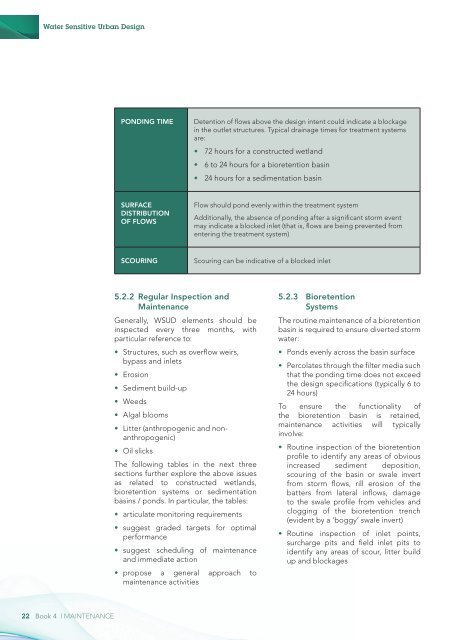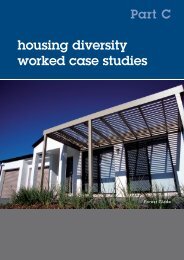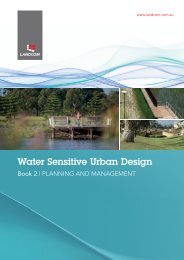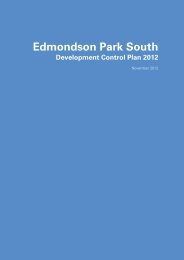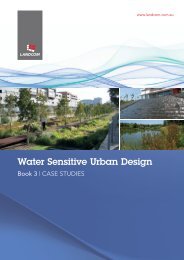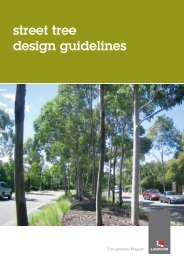Landcom Book 4 Maintenance - WSUD
Landcom Book 4 Maintenance - WSUD
Landcom Book 4 Maintenance - WSUD
You also want an ePaper? Increase the reach of your titles
YUMPU automatically turns print PDFs into web optimized ePapers that Google loves.
Water Sensitive Urban Design<br />
Ponding time<br />
Detention of flows above the design intent could indicate a blockage<br />
in the outlet structures. Typical drainage times for treatment systems<br />
are:<br />
••<br />
72 hours for a constructed wetland<br />
••<br />
6 to 24 hours for a bioretention basin<br />
••<br />
24 hours for a sedimentation basin<br />
Surface<br />
distribution<br />
of flows<br />
Flow should pond evenly within the treatment system<br />
Additionally, the absence of ponding after a significant storm event<br />
may indicate a blocked inlet (that is, flows are being prevented from<br />
entering the treatment system)<br />
Scouring<br />
Scouring can be indicative of a blocked inlet<br />
5.2.2 Regular Inspection and<br />
<strong>Maintenance</strong><br />
Generally, <strong>WSUD</strong> elements should be<br />
inspected every three months, with<br />
particular reference to:<br />
••<br />
Structures, such as overflow weirs,<br />
bypass and inlets<br />
••<br />
Erosion<br />
••<br />
Sediment build-up<br />
••<br />
Weeds<br />
••<br />
Algal blooms<br />
••<br />
Litter (anthropogenic and nonanthropogenic)<br />
••<br />
Oil slicks<br />
The following tables in the next three<br />
sections further explore the above issues<br />
as related to constructed wetlands,<br />
bioretention systems or sedimentation<br />
basins / ponds. In particular, the tables:<br />
••<br />
articulate monitoring requirements<br />
••<br />
suggest graded targets for optimal<br />
performance<br />
••<br />
suggest scheduling of maintenance<br />
and immediate action<br />
••<br />
propose a general approach to<br />
maintenance activities<br />
5.2.3 Bioretention<br />
Systems<br />
The routine maintenance of a bioretention<br />
basin is required to ensure diverted storm<br />
water:<br />
••<br />
Ponds evenly across the basin surface<br />
••<br />
Percolates through the filter media such<br />
that the ponding time does not exceed<br />
the design specifications (typically 6 to<br />
24 hours)<br />
To ensure the functionality of<br />
the bioretention basin is retained,<br />
maintenance activities will typically<br />
involve:<br />
••<br />
Routine inspection of the bioretention<br />
profile to identify any areas of obvious<br />
increased sediment deposition,<br />
scouring of the basin or swale invert<br />
from storm flows, rill erosion of the<br />
batters from lateral inflows, damage<br />
to the swale profile from vehicles and<br />
clogging of the bioretention trench<br />
(evident by a ‘boggy’ swale invert)<br />
••<br />
Routine inspection of inlet points,<br />
surcharge pits and field inlet pits to<br />
identify any areas of scour, litter build<br />
up and blockages<br />
22 <strong>Book</strong> 4 | MAINTENANCE


